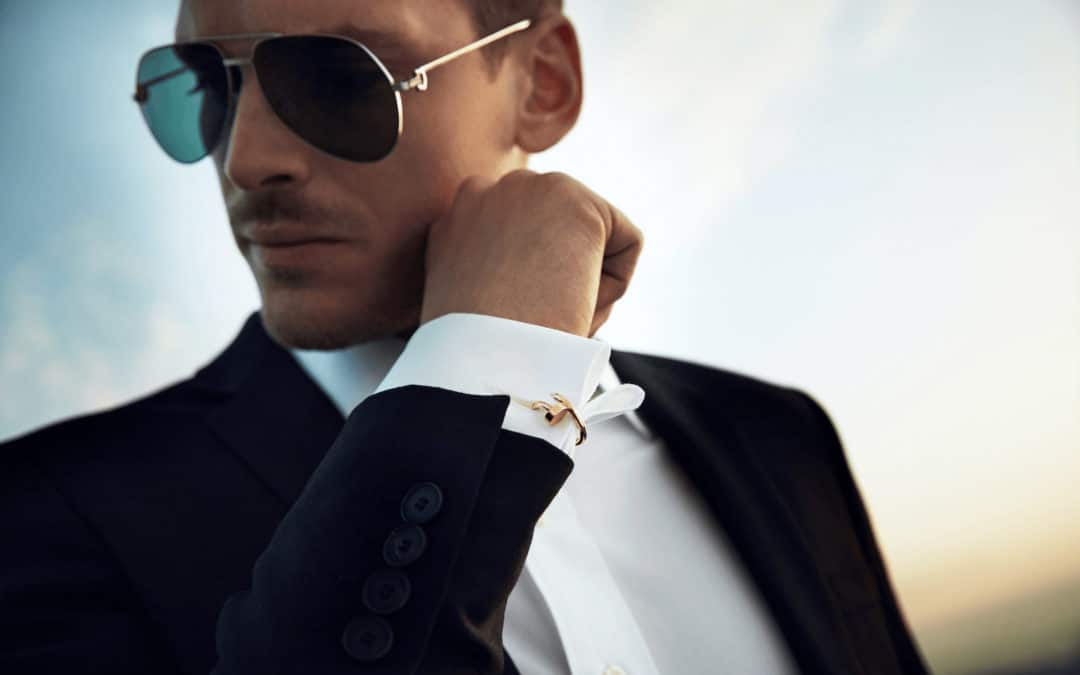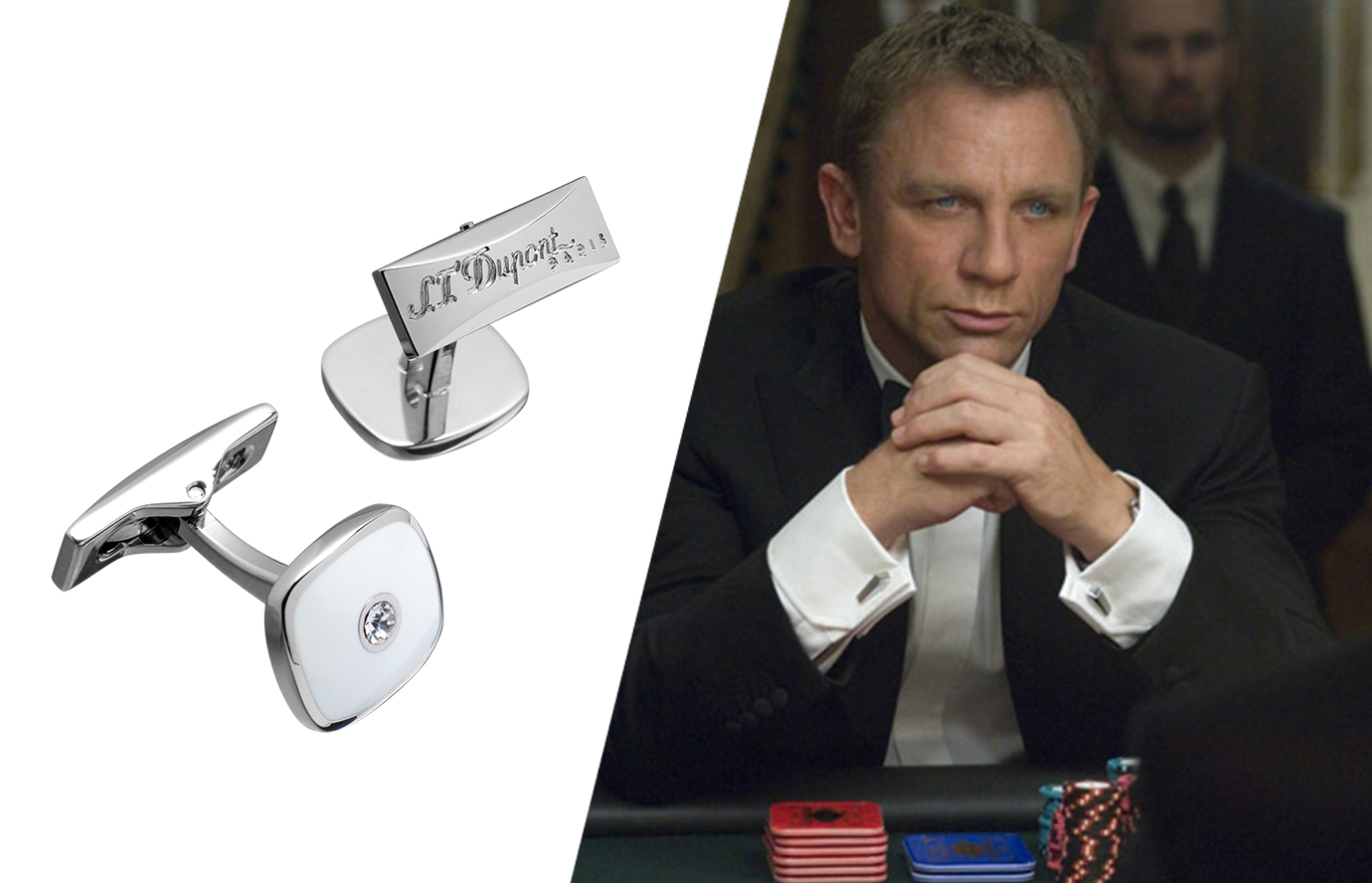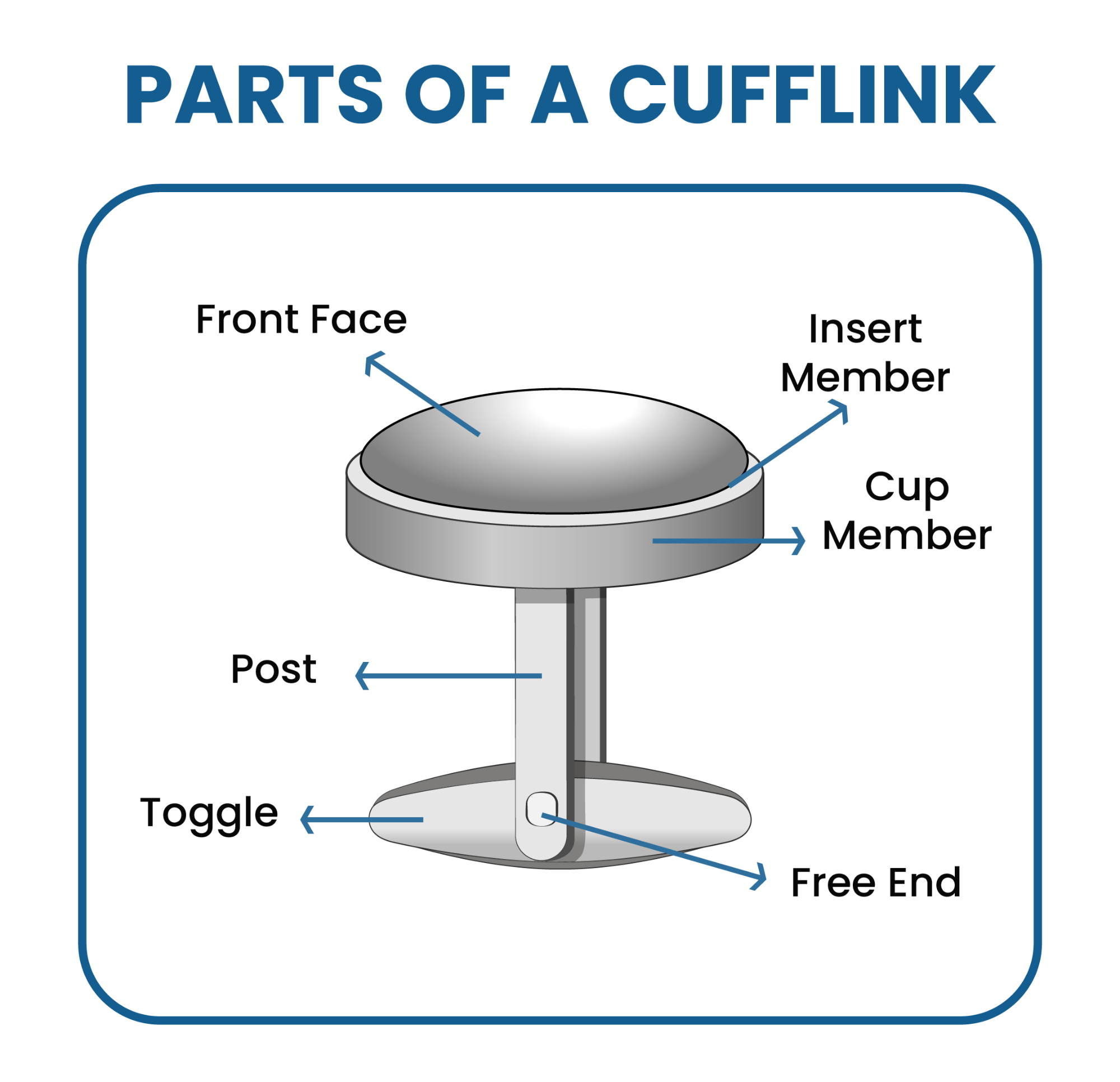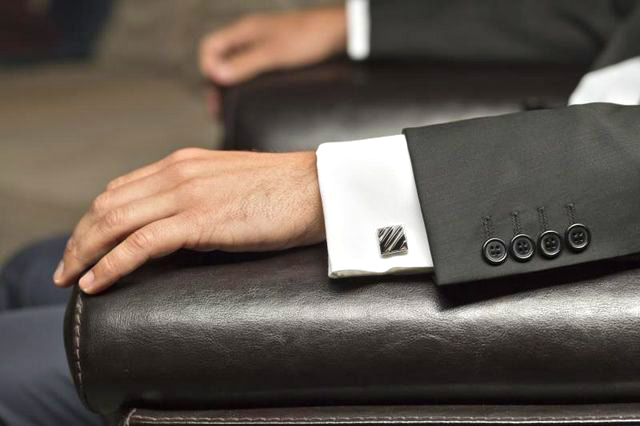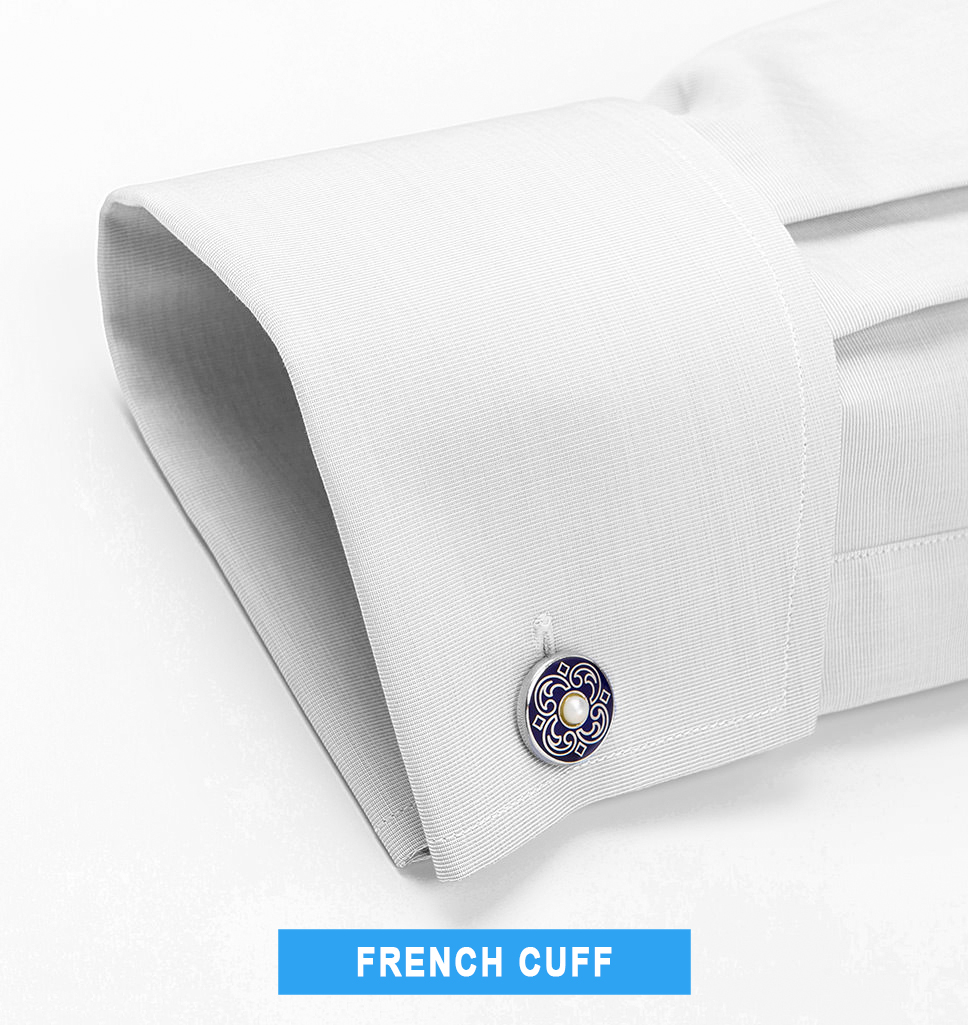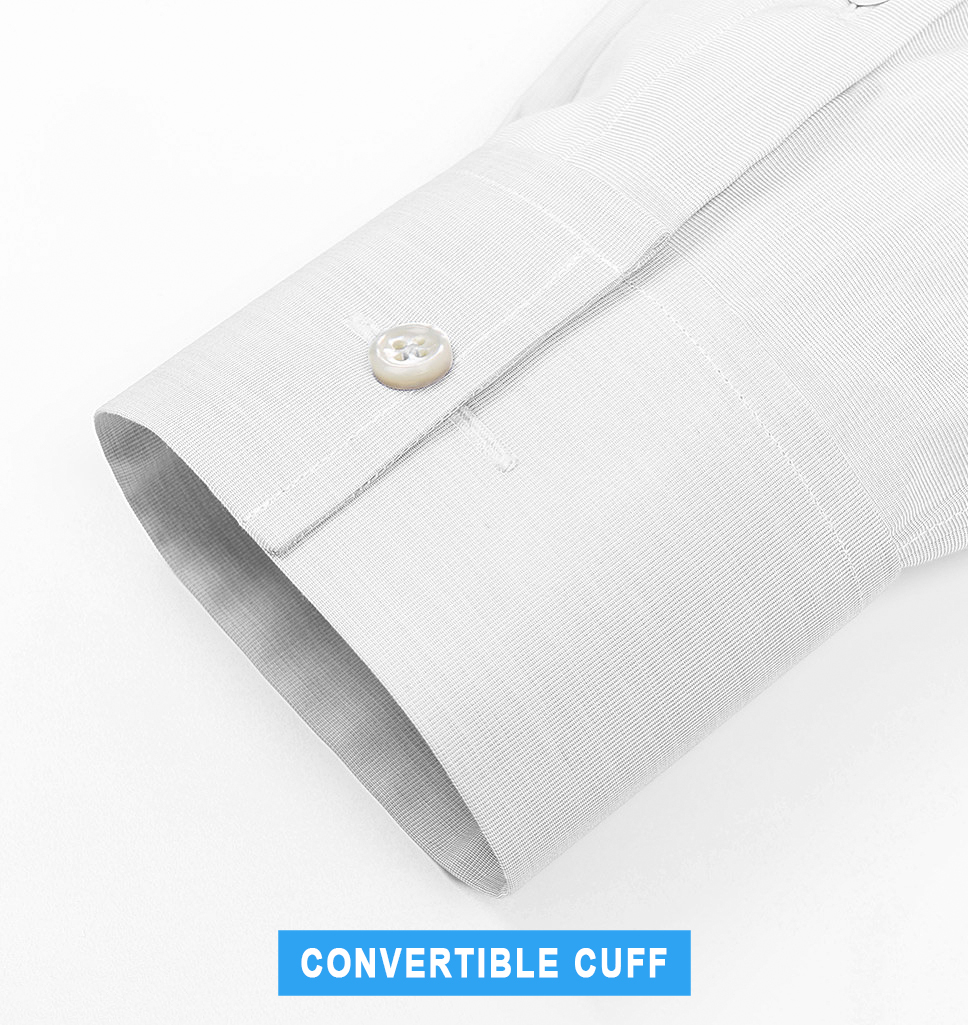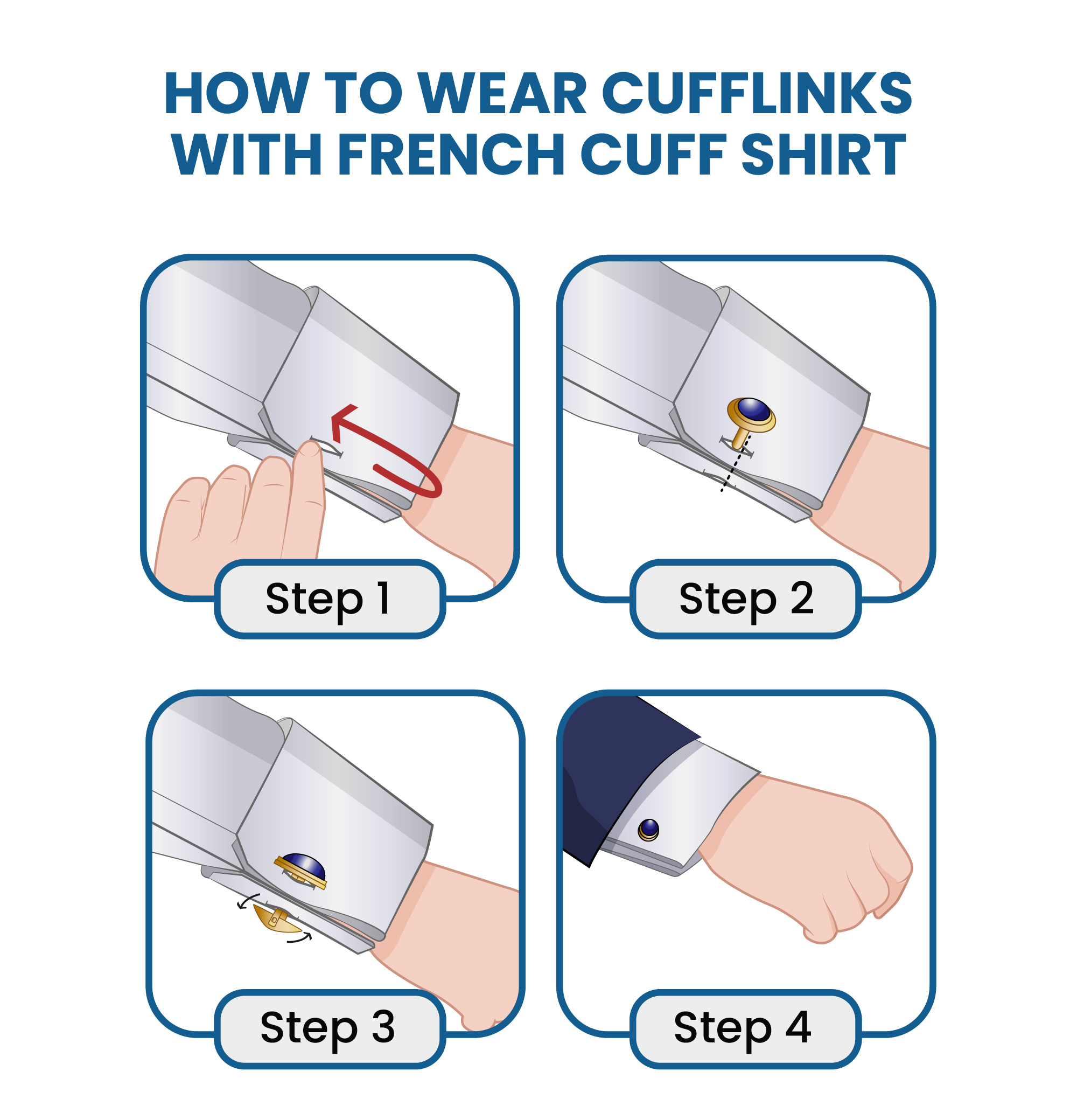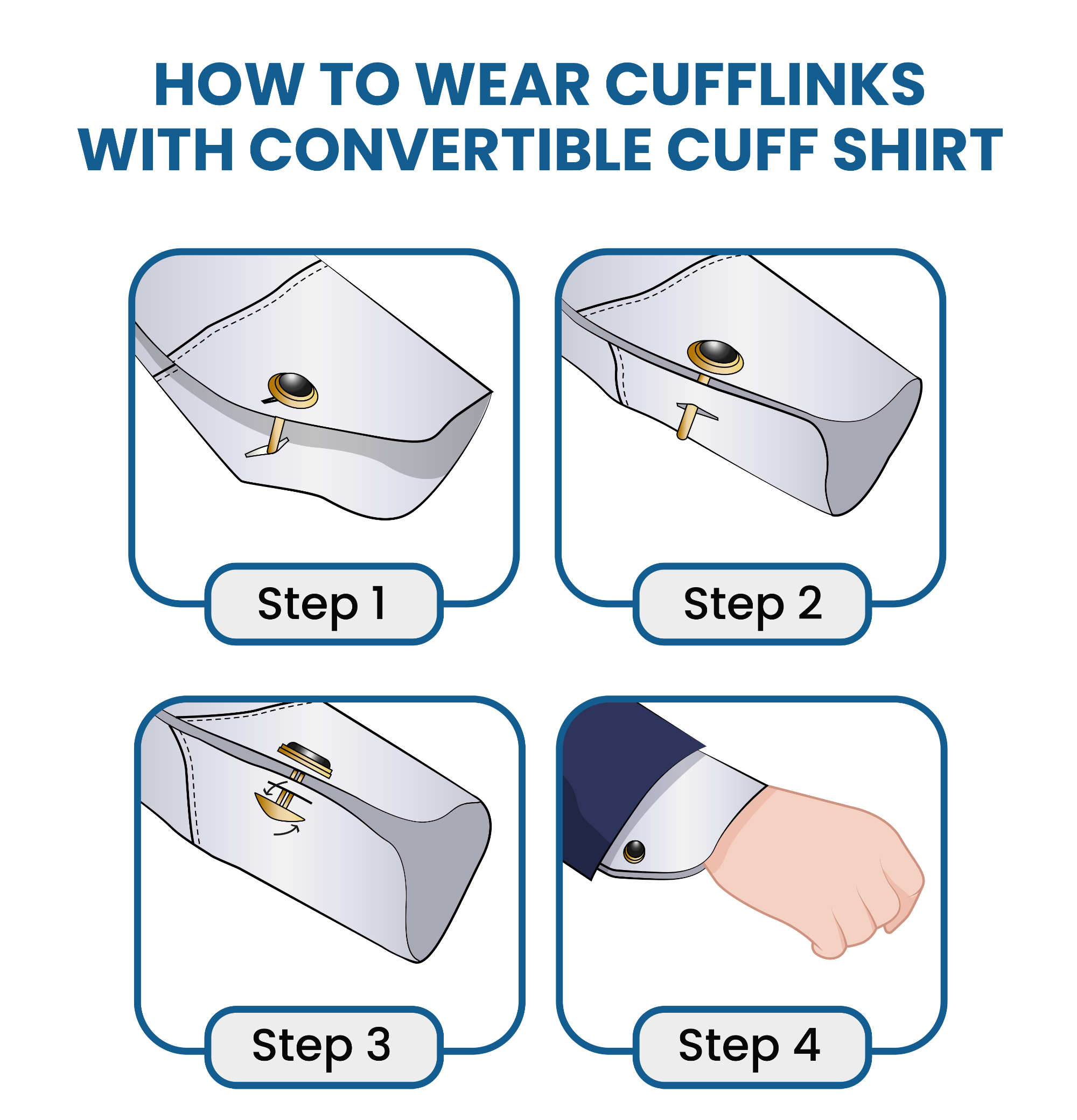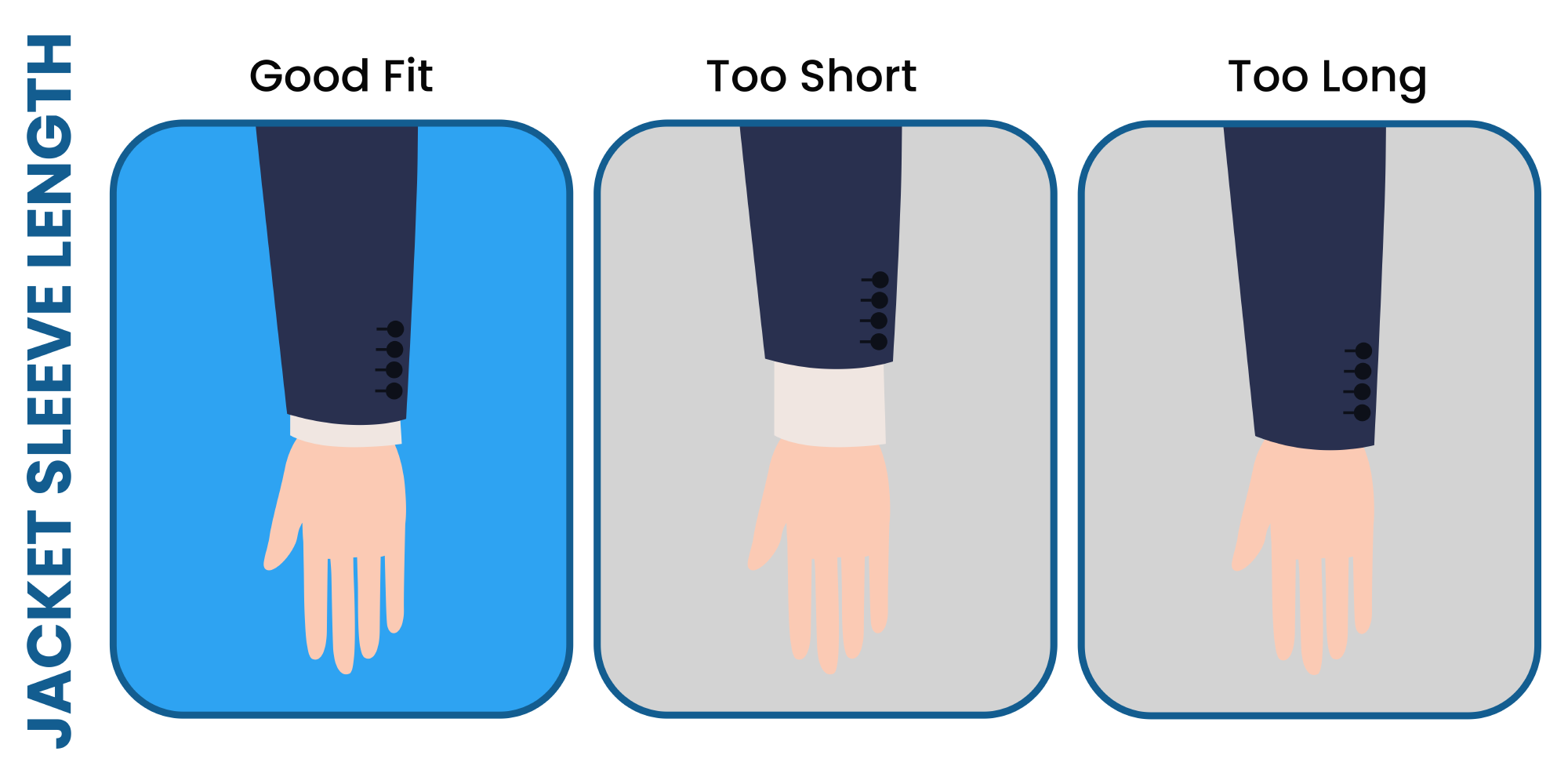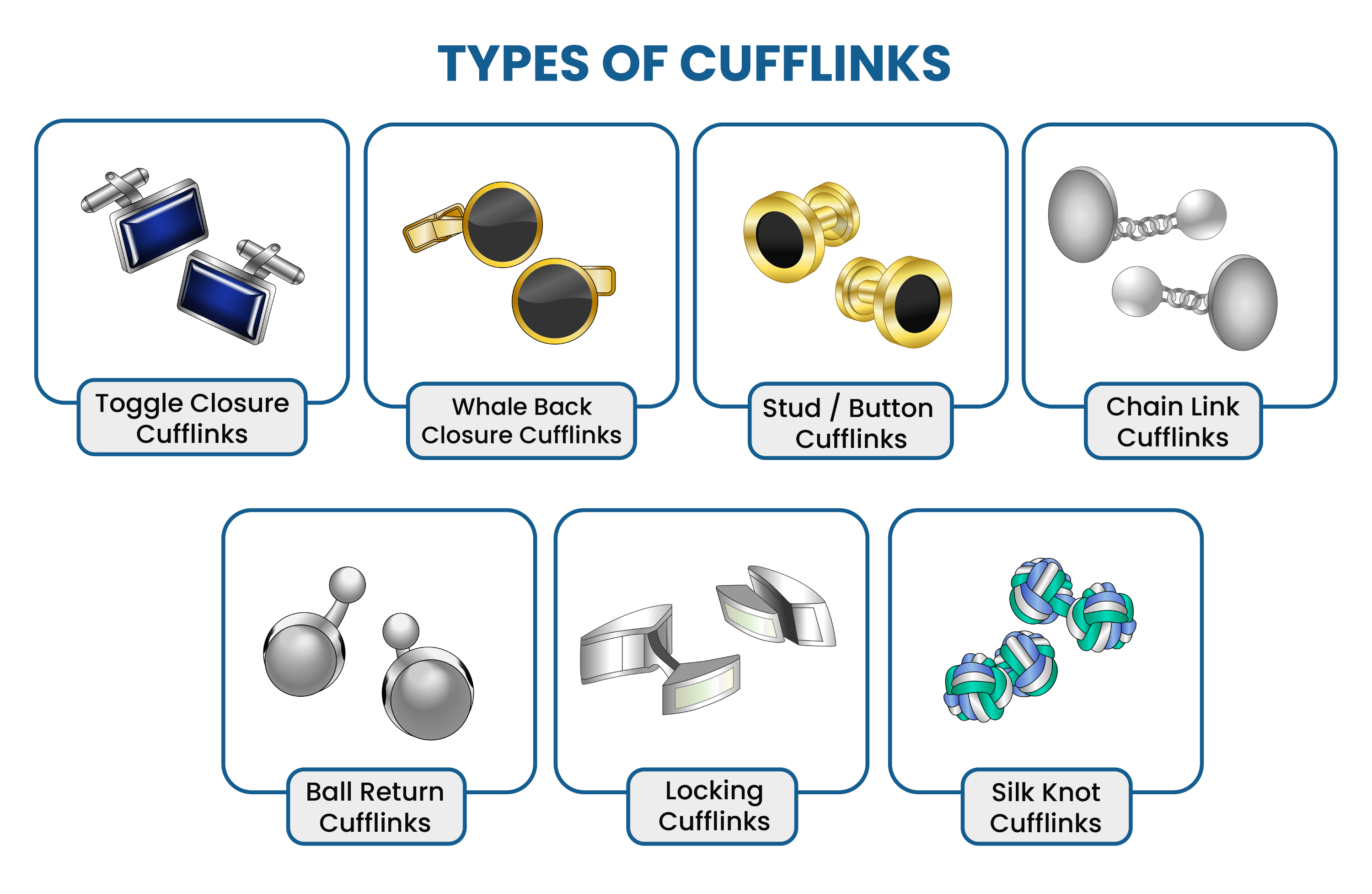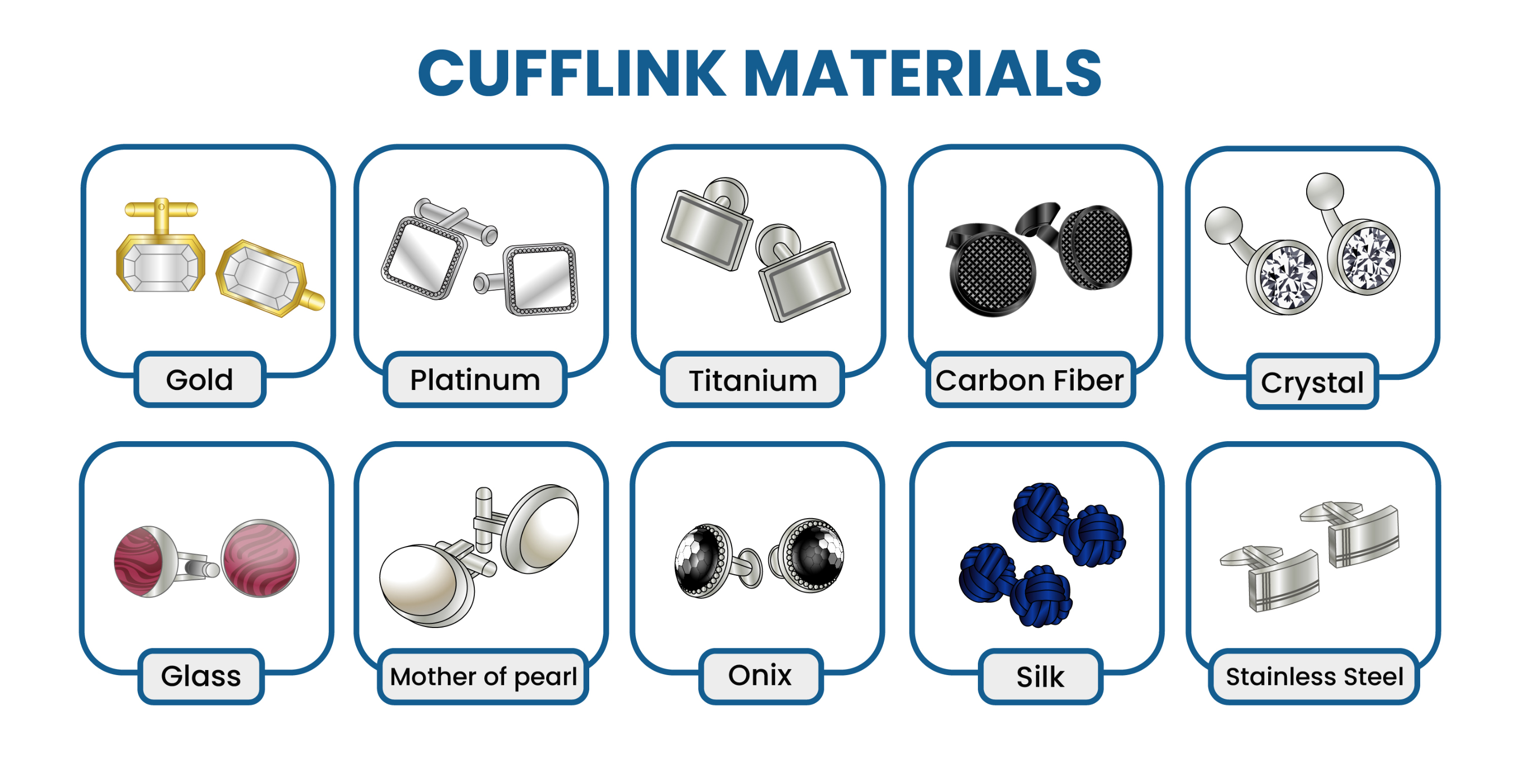There’s no denying the cool factor of a cufflink. They make any suit or dress shirt instantly chic. And if you think that only a certain caliber of men can wear cufflinks, think again.
But perhaps you don’t wear cufflinks because you’ve been simply intimidated by them? Don’t worry; anybody can, and should, put on cufflinks when necessary.
What are Cufflinks
Cufflinks are a suit accessory that acts as a glorified button, holding your cuffs closed on your dress shirt. They are a piece of jewelry and a tool, both decorative and functional.
Cufflinks are traditional in formalwear. You’ll usually find them along with tuxedos and semi-formal suits, though they aren’t limited to just those.
Some fashion-forward men will incorporate them into business wear and even some smart casual outfits. That’s because cufflinks make your outfit more unique than most standard suits.
Different Cufflink Parts
There are three main parts to a cufflink: the head, the post, and the toggle.
The head, or front face, is the decorative part that faces out. This is the part that everybody will see on your wrist.
It can be made from any number of materials, from metal to gemstone to glass. The head will determine how fancy (or not) your cufflinks are.
The post is the part that slides through the buttonhole in the cuff. It connects the two sides of the fabric and holds them together. It is also the piece that joins the head and the toggle together.
The toggle is the bottom piece of the cufflink. It is the locking mechanism that closes the cufflink in place, so it doesn’t fall out.
When to Wear Cufflinks
Cufflinks are a classy adornment on formal occasions. They are almost always associated with black-tie attire, but they don’t need to stop there.
Cufflinks elevate your style and are that extra touch that shows that you pay attention to detail. So, you can wear them with a dress shirt or tuxedo shirt, and also with business attire. Some men also add them to more casual shirts.
If your dress shirt has French cuffs, you’ll need to add cufflinks. They are required to keep your cuffs from flapping around your wrists.
Cufflinks aren’t required for barrel cuffs since that type of shirt already has buttons at the wrist.
How to Use Cufflinks
French cuffs are different from the standard barrel cuff in that they are about twice the length of the standard cuff.
They fold back over themselves to create two layers. Without cufflinks, the fabric just stays open because they don’t have buttons.
You don’t have to buy only French cuff shirts if you would like to use cufflinks.
Some shirts have convertible cuffs that allow for either style. They have simple barrel cuffs with buttons but also have buttonholes that allow for cufflinks.
Do you have dress shirts that have neither French nor convertible cuff type? Then, you can take them to a tailor to have them converted so that they, too, can accommodate cufflinks!
The tailor will add a buttonhole on either side of the cuff where the cufflink can be inserted. Of course, don’t use the buttons when the cufflinks are inserted.
How to Wear Cufflinks with a Shirt
The way you can insert and wear your cufflinks properly depends mostly on the shirt cuff type.
So again, the cuff is an essential part of your shirt; and since the cufflink actually rests there, ensure you have some general understanding of the different shirt cuffs.
Wearing Cufflinks with a French Cuff Shirt
If your shirt has French cuffs, you will need cufflinks in order to prevent your cuffs from flapping all over. Cufflinks are simple to use once you get the hang of them, which may be tricky at first because you’ll be using one hand.
- Fold back the cuff over itself.
- Ensure the buttonholes line up. You should now have two buttonholes each on either side of the fabric, creating four holes on top of each other.
- Insert the cufflink post through the four layers of fabric. The decorative head should be at the bottom of your wrist.
- If you are using the clasp type of cufflink, close the toggle to lock the cufflink in place.
Wearing Cufflinks with a Convertible Cuff Shirt
The process for shirts with convertible barrel cuffs is very similar, though slightly different.
- Leave the cuffs of your shirt unbuttoned.
- Pull the edges of your cuff together and flat so that the holes line up. The insides of the cuff will be pressed together.
- Insert the post of your cufflink through the holes.
- Secure the cufflink in place by closing the clasp.
When wearing a tuxedo shirt, you will need to keep in mind that the shirt doesn’t have regular buttons. Instead, a tuxedo shirt has shirt studs down its front to keep the shirt closed.
Button studs are often made of precious metal and sometimes have a decorative inlay. Your cufflinks should match those studs!
How to Wear Cufflinks with a Suit
If you worry that cufflinks may be a waste because your suit jacket will just hide them, fret not. Your shirt sleeve should always peek out of your suit jacket, which means that your cufflinks would be seen if the length is correct.
A well-tailored suit jacket will fall a little short of your shirt sleeve. The entire length of your sleeve should not hang out from your jacket; instead, it should be only about ½ inch that’s visible.
This may not feel like it leaves much room for your stylish cufflinks to be seen but just wait.
When you sit down and bend your arms, your jacket sleeves will rise a bit further up your arm. This is when your cufflinks will be most visible, allowing others to see your impeccable style.
Different Types of Cufflinks
Cufflinks don’t all work exactly the same way. There is a variety of ways they are designed to hold your cuffs together. Some have closures that lock in place, and some don’t.
A toggle closure refers to the bottom part of the cufflink. It is also sometimes called a bullet back closure. It starts out vertical and acts as a post when you are inserting it through the buttonhole. Once inserted, it flips on a hinge and lays horizontally across the fabric to secure the cufflink in place.
A whaleback closure is the most common type of cufflink. It consists of a flat head and a post that also flips to hold the cufflink in place. It’s named whaleback closure because it resembles a whale tale when the post is flipped shut to close it. This style is straightforward to use.
Stud closures have no hinges. Instead, they consist of a head, a post, and a small backing. You just slip the small backing into place through the buttonholes at an angle.
Silk knot cufflinks have two knotted balls connected with a silk cord. The head of each side is slipped through each side of the cuff. This cufflink style is looser than the other styles.
Locking cufflinks are a modern style similar to a watch closure since they act more like a clip. Although this version is very different from the others, it is still super easy to use.
Different Cufflink Materials
Just as cufflinks have various ways to secure them, they are also made from a wide variety of materials. The type of material you choose will determine how fancy and luxurious your cufflinks are.
A plain metal cufflink can come in materials such as gold, platinum, titanium, or silver. Metal is a shiny, durable option that can be as simple or ornate as you choose.
For a semi-formal cufflink, mother of pearl is a beautiful, subdued choice for your cufflinks. This material is made from the iridescent inner layer of shells. Mother of Pearl cufflinks often resembles buttons since that’s what semi-formal wear buttons tend to be made from.
Carbon fiber is a very strong material for cufflinks. These pieces are often very sleek, featuring modern designs. These are usually dark and metallic looking, sometimes referred to as gunmetal color.
Other options include onyx, silk, and glass. They all come in many color options. Black is the most formal option in any of these materials. Onyx is the most formal of these, with silk following. Glass tends to be the least traditional, usually used for more casual cufflinks.
How to Wear Cufflinks FAQs
Now that you know the basics of wearing cufflinks, here’s a lightning-speed question round. Refer back to these faqs for a quick refresher or for any burning questions we may have missed.
How to properly fasten a cuff with cufflinks?
You want to make sure that your cufflink post has appropriately been inserted into each buttonhole. The head, which is the design face, should be positioned at the inside of your wrist so that it’s visible when you move. Next, turn the clasp or toggle to lock your cufflink into place. Voila! You have secure cuffs.
Should I match the cufflinks and the button studs on a tuxedo shirt?
Absolutely. This is a great opportunity to pull your entire ensemble together. The attention you pay to these small details in your formal wear will add up to one classy look. If your stud and your cufflinks don’t match, they will be a glaring mismatch to an otherwise sophisticated outfit.
Which cufflink type and material should I pick for black-tie events?
Just as black is always the most formal color in suits, black would be your most formal option with your cufflinks, as well. A sleek onyx look with a simple design would look immaculate. You can also opt for a metallic style for your cufflinks. This is a shinier option but will also look cultured.
Can I wear cufflinks if my shirt doesn’t have cuff holes?
Yes, you absolutely can still wear cufflinks if your shirt isn’t cufflink-ready! You can take your dress shirts to a tailor, who will be able to convert them into sleeves that can accept cufflinks easily. They’ll add buttonholes on your cuffs, which will be where you can insert the posts of your piece. If you do this, then you won’t use the buttons that are already there.
Do I need to match the cufflinks with the suit?
You don’t necessarily need to have your cufflinks match your suit. You can choose designs and colors that complement the colors in your suits. If you want to create a monochrome look, however, then you would make sure your cufflinks are the same color as your suit jacket and pants. That would be a great way to pull it all together.
Hi, I’m Alex, and I’ve studied and specialized in styling in Rome. Through my writing, I want to help men dress well and learn the purpose and significance of suits and other formal attire. My final goal is to make men more confident in their wardrobe choice and life in general.
